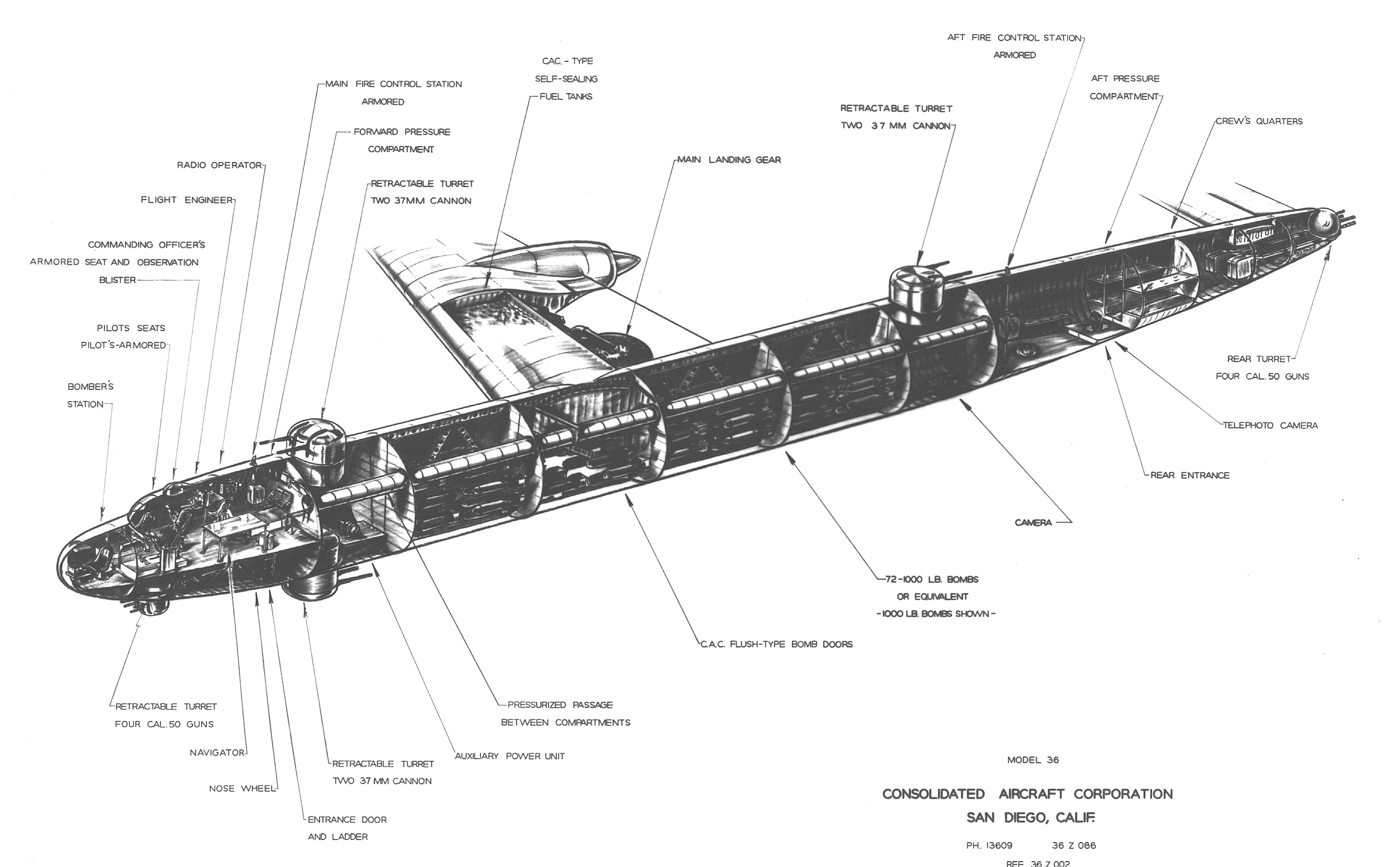Aug 052010
A cutaway of the Consolidated Model 36, circa 1941. This would eventually become the B-36. Main changes included a resculpt of the cockpit, the change from twin rudders to a single rudder, and a wholly reworked defensive armament system. As shown here it used retractable turrets with a range of weapons (50 cal to 37mm); the final aircraft would use standardized 20mm cannon.
9 Responses to “Very Early B-36 cutaway”
Sorry, the comment form is closed at this time.

72000 LB or 32 metric tons payload of Bombs ?!
the Nazi Amerika-Bomber proposals had maxium payload of
8818 LB or 4 metric tons
sad the B-36 never came to use in WWII, had be superb vision:
USAAF come with airfleets of B-36 and
Bomb the Thrid Reich really back to Stoneage
poor Herman Göring …
interesting that the bomb aimer is referred to as the ‘bomber’…
Considering that the Japanese were awe-struck by the size of the B-29 when they encountered it (“Like huge silver bulls charging through the clouds in the moonlight”… boy, could those guys ever write!) one has to imagine their reaction if they ever ran into a B-36: “Immense…but under-armed.”
…then all the twin 20 mm cannon turrets start to emerge from inside the fuselage… 😀
That approach made a lot more sense than the one shown here, with the non-retractable 37 mm cannon turrets; that’s going to hurt the top speed by around 50-75 mph, easily.
Anyone who hasn’t seen the movie “Strategic Air Command” has to see it at the first opportunity, because it shows not only the awe-inspiring majesty of the B-36, but also just how beautiful the B-47 was.
“She’s a beauty!” – Jimmy Stewart.
Boy, I wouldn’t disagree with that – the B-47 was a _ really_ great looking aircraft, particularly given just how fast Boeing took the German swept-wing research from WWII and turned it into a operational aircraft.
The original specification for what became the B-36 was pretty ambitious, including the 70,000 lb bomb load, 450 mph over the target, and a combat radius of 6000 mi. (with a smaller bomb load though). The assumption was that we would have to bomb Germany from bases in northeastern North America if England fell. As it turned out, this was too ambitious, and by later in 1941, the spec had been revised to what was essentially the B-36 as we know it.
There are a couple of weird things on the propulsion side, like the Lycoming XR-7755 and a weird Boeing turboprop, the designation of which I can’t remember a the moment, that seem to have been kept in development at a low level in case the trans-oceanic requirement ever re-emerged. The B-36’s own Pratt R-4360 was a tour de force in its own right.
As for whether it should have been pushed ahead during WWII, IMO we had such trouble getting the B-29 and the Wright R-3350 in production that it might have been a major complication to try to do the B-36 too. Plus, by late 1944, we essentially had air superiority in Europe and could switch to tactical aviation as the main offensive force. In the Pacific, the island bases were being put in place and we could reach Japan with B-29/32 class aircraft, so the range/payload of the B-36 wasn’t critical.
The Air Force even went the other way with the XB-42, trying to put a B-29 bomb load in the smallest and simplest package possible.
On another board I asked the question about what if the B-29 was canceled for the B-36. One of the posters said the -36 probably would have been rolling off the production lines by mid-1945. Even earlier if they had pushed harder.
He also said the while the -36 was bigger the -29 actually had more of a complicated design. The P&W R-4360 actually had fewer problems once the bugs were worked out then the R-3350.
Nice thing about the -36 was with those big wings they could climb above the max altitude of the best Japanese fighters. Even if they did get up there the -36 was actually more manuverable!
Looking at the picture more closely, it says the turrets are retractable; but I don’t exactly see how that’s supposed to work.
On the operational ones, the 20mm gun turrets turned down onto their sides and retracted under sliding doors:
http://www.alphasim3.com/Gallery/albums/usaf/b36/normal_B-36_6.jpg
[…] timely followup to this post, here is a cutaway illustration of the Consolidated Vultee Model 36 (development phase of the B-36) […]
The whole story of theB-36 vs. B-35 competition is in my just published book “Goodbye Beautiful Wing” at goodbyebeautifulwingbook.com…explains the B-36’s performance and shortcomings, compared to teh Northrop Wing, which had a lower wing loading, a higher power loading, a higher Critical Mach number, a higher power-to-wetted-area number… in short, was better in every way than the B-36, and cost half as much, was 60 mph waster, could cruise two miles higher — avove USSR insterceptors incept the new MiG-15s, and could turn inside them.
One thing the Convair had was political influence of Floyd Odlum, CEO of Convair and a friend of AF Secretary Stuart Symington, and also of Loujis Johnson, Secretary of Defense. Odlum’s wife, Jackie Cochran, was a close personal friend of top AF generals from before WW II, having won the 1938 Bendix Trophy at theCleveland National Air Races… and the Odlum’s estate executor later would be Chuck Yeager… So when Symington demanded Northrop ‘merge’ with Convair and Jack refused, the AF and SecDef cancelled Wings and were ablet o buy 75 more B-36s that they had just cancelled… and this caused a Congressional Investigation, charging Odlum with bribing Johnson to cancel a being-built super aircdraft carrier… an event the media billed as “revolt of the Admirals’ who were enraged, and one resigned in protest. This and an amazing numnber of similar events are told about this competition.
Very interesting plane that was.